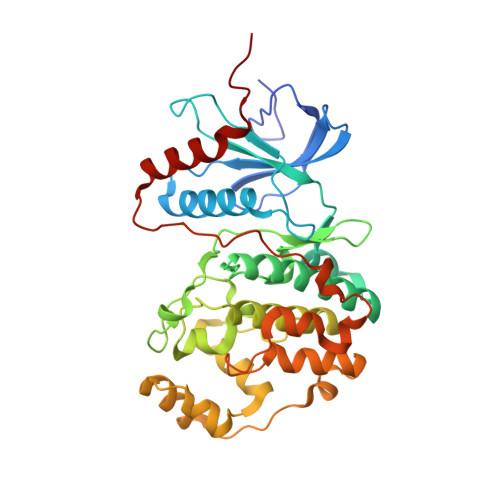Nuclear ERK translocation is mediated by protein kinase CK2 and accelerated by autophosphorylation.
Plotnikov, A., Chuderland, D., Karamansha, Y., Livnah, O., Seger, R.(2011) Mol Cell Biol 31: 3515-3530
- PubMed: 21730285
- DOI: https://doi.org/10.1128/MCB.05424-11
- Primary Citation of Related Structures:
3R63 - PubMed Abstract:
The extracellular signal-regulated kinases (ERK) 1 and 2 (ERK1/2) are members of the mitogen-activated protein kinase [MAPK] family. Upon stimulation, these kinases translocate from the cytoplasm to the nucleus, where they induce physiological processes such as proliferation and differentiation. The mechanism of translocation of this kinase involves phosphorylation of two Ser residues within a nuclear translocation signal (NTS), which allows binding to importin7 and a subsequent penetration via nuclear pores. Here we show that the phosphorylation of both Ser residues is mediated mainly by casein kinase 2 (CK2) and that active ERK may assist in the phosphorylation of the N-terminal Ser. We also demonstrate that the phosphorylation is dependent on the release of ERK from cytoplasmic anchoring proteins. Crystal structure of the phosphomimetic ERK revealed that the NTS phosphorylation creates an acidic patch in ERK. Our model is that in resting cells ERK is bound to cytoplasmic anchors, which prevent its NTS phosphorylation. Upon stimulation, phosphorylation of the ERK TEY domain releases ERK and allows phosphorylation of its NTS by CK2 and active ERK to generate a negatively charged patch in ERK, binding to importin 7 and nuclear translocation. These results provide an important role of CK2 in regulating nuclear ERK activities.
- Department of Biological Regulation, Weizmann Institute of Science, Rehovot 76100, Israel.
Organizational Affiliation:
















